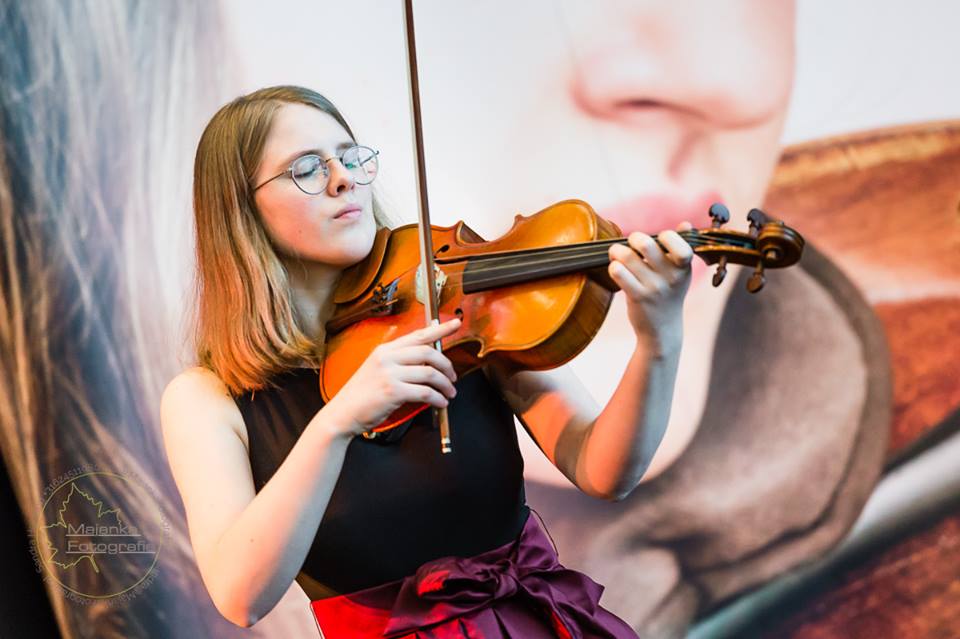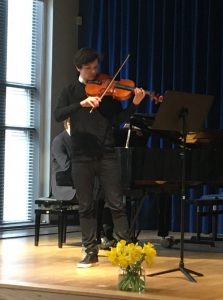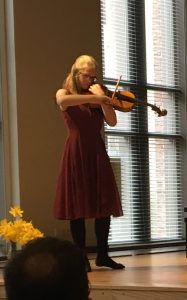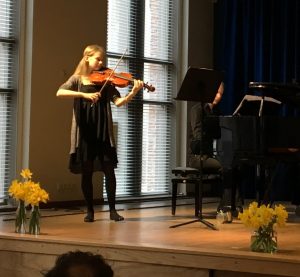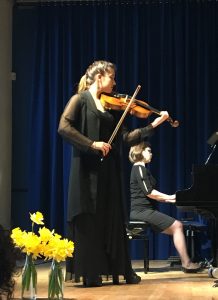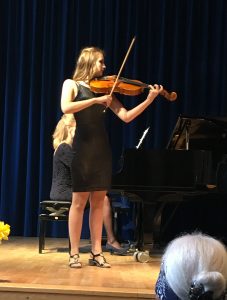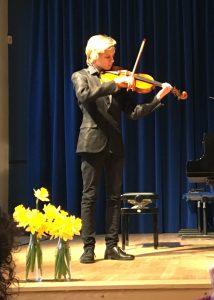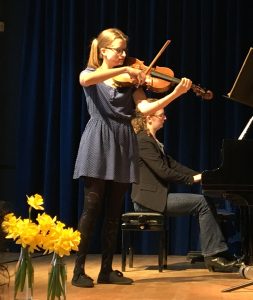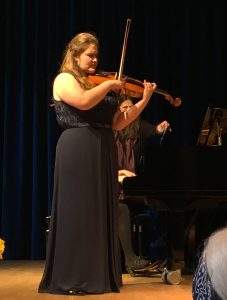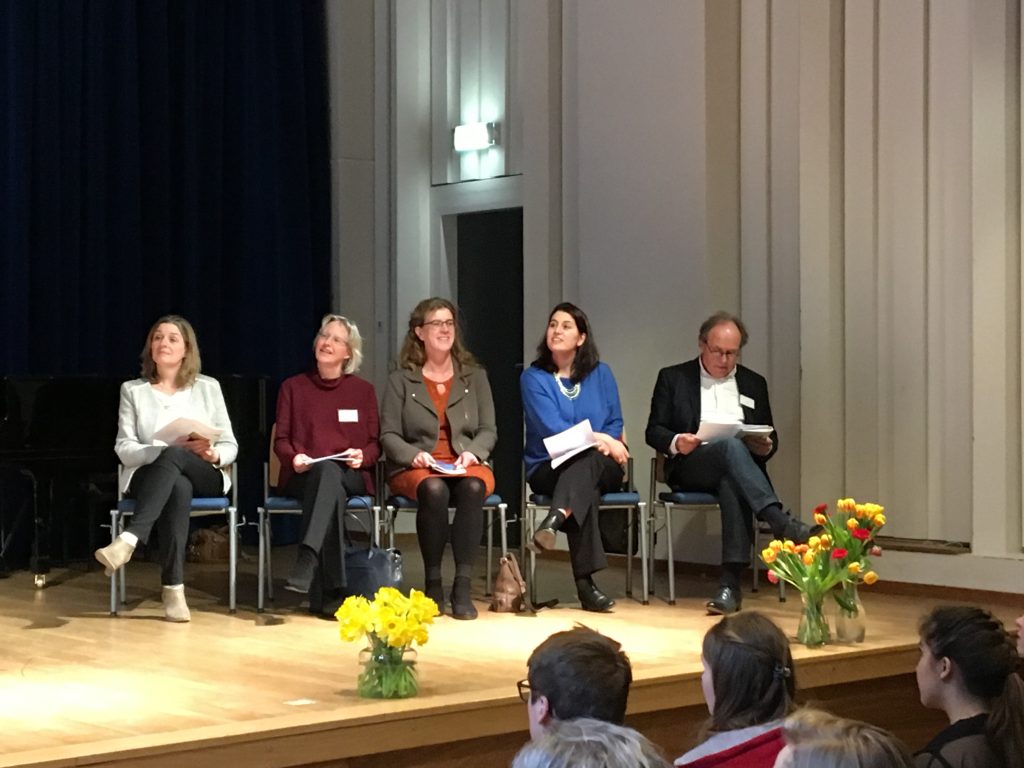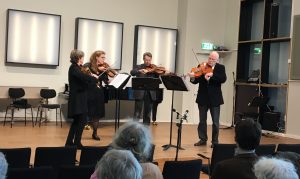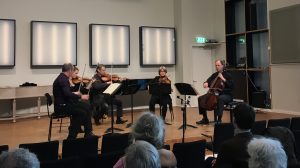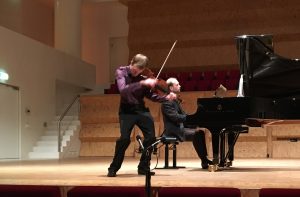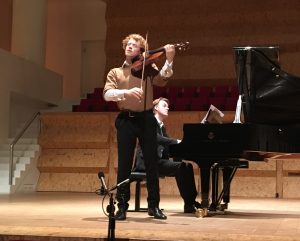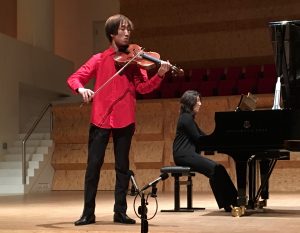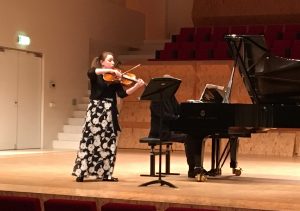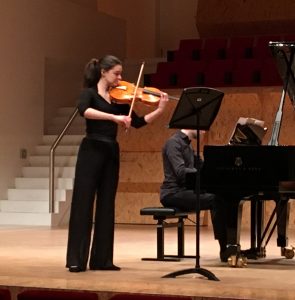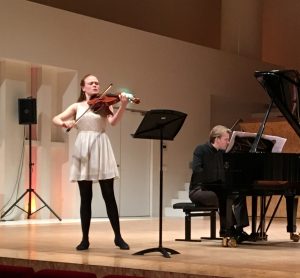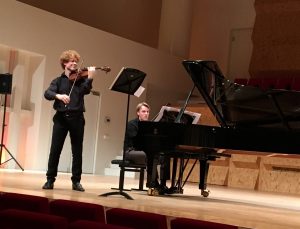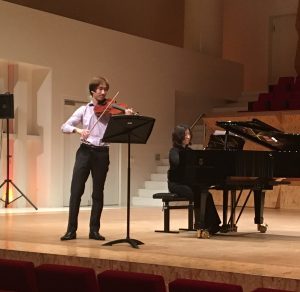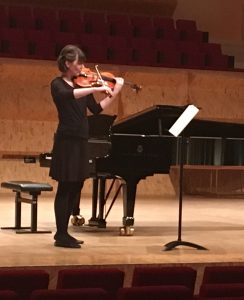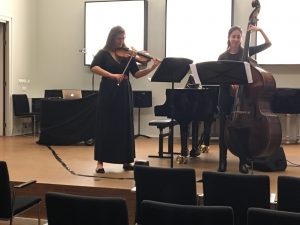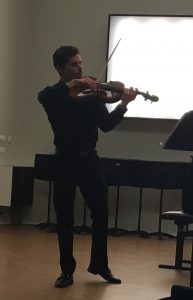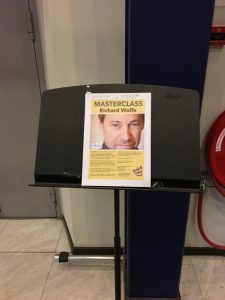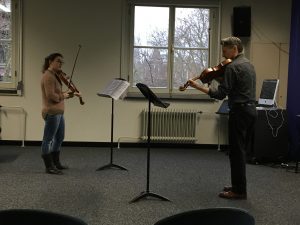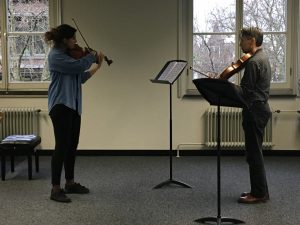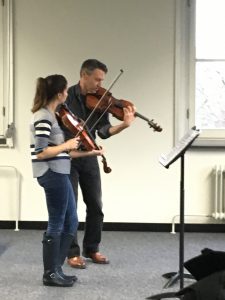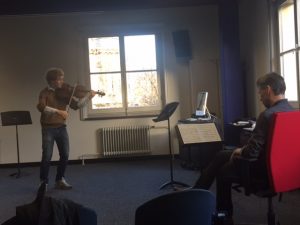door Kristofer G. Skaug
English version below! Follow this link.

Jury vlnr: Jürgen Kussmaul, Hannah Strijbos, Eric vd Wel, Roland Kieft
Wij zijn vroeg aanwezig, om geen ene noot van Dag 2 van de 1e Ronde te hoeven missen. De jury heeft er ook duidelijk zin in.
Masterstudente Lara Albasano bijt de spits af met een hele schone Mozart (G). De “Skip Count” van Oene van Geel is technisch zeer goed, en lijkt toch behoorlijk relaxed! De Enescu was eveneens steengoed, haar spel is heel volwassen. Als ik heel picky zou moeten zijn, heel af en toe haperde het samenspel met Daniël Kramer… ietsje. Maar hier is een statement gemaakt, het zal voor menigeen dringen worden om de volgende ronde te bereiken van dit concours.

Kellen en Danielle
Kellen McDaniel komt uit Californië, maar studeert bij Zemtsov in Den Haag. Hij opent met Mozart in G, samen met Danielle Daoukayeva op viool, met wie hij al jaren in het Babylon kwartet samenspeelt, en dat is goed te horen. Ondanks enkele foutjes is het een charmante vertolking. Enescu met Gerard Boeters wordt iets meer “op zeker” gespeeld. En dan, voorafgegaan met een “one, two, one-two-three-four” – zijn Skip Count is met stip de meest catchy versie tot nu toe, met meedeinende bassist, alerte timing en swingende energie. De bassist helpt ook mee in “Gesualdo” met enkele diepe ondertonen. De vrije improvisatie is goed aan Kellen besteed. Interessante beurt!
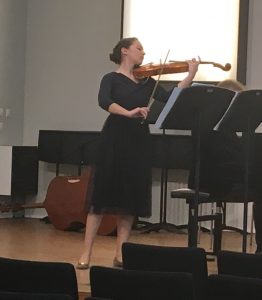
Kardelen Buruk
De uit Turkije afkomstige Kardelen Buruk begint met Enescu. Een beetje tam in de inleiding, maar gaandeweg komt ze in een goede flow. Haar Mozart gaat ook goed. In Skip Count raakt ze de bassist even kwijt, maar ze herpakt zich en maakt het stuk toch nog met veel bravoure af. In Gesualdo veel flageoletten in de improv, fraai afgerond met een paar sappige Bartok-pizzicato’s.
En dan komt met Lotus de Vries en verrassing: Eindelijk iemand die het “andere” Mozart duo in Bes groot (KV424) speelt. Het is technisch voor met name de viool wat pittiger. Maar de toonsoort is wel heel goed geschikt voor een mooie altvioolstem, en bij Lotus komt die heel mooi uit de verf. In de improvisaties van “Gesualdo’s bovenkamer” komt er eerst een lieflijk volksliedje en daarna iets dat me doet denken aan een motief uit Shostakovich 10e symfonie, maar dan veel heftiger. Enescu is wat zwaar, maar ze komt er goed uit.
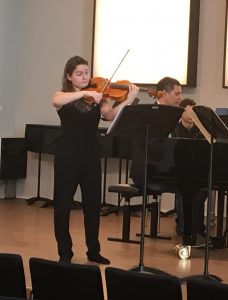
Esther Fernandez Olalla
De volgende is Esther Fernandez Olalla, een studente van Karin Dolman in Rotterdam. Ze wordt begeleid door Roderigo Robles de Medina in het Concertstuk van Enescu, dat gaat prima! Ze heeft zeker voortgang gemaakt sinds de masterclass met Richard Wolfe vorige maand, waar ze ditzelfde stuk voorspeelde. “Skip Count” biedt een dramatische plot twist – Esther laat zich begeleiden door haar docent op altviool! Strict gesproken onreglementair, maar daarom ook best leuk. Het relatief gebrek aan een dwingende baspuls wordt wel deels goedgemaakt door zelfgemaakte swing. Not bad! De Mozart biedt een andersoortige personele première – want voor de eerste keer zien we een mannelijke violist op het podium, een secuur en muzikaal spelende Manuel Muñoz. Toch ontbrak in dit stuk muzikale spanning.
Vierdejaars KC-studente Sophie Vroegop komt nu op samen met Vera Werkman voor het Bes-groot duo van Mozart. Er wordt fijne samenklanken gemaakt, ondanks wat intonatiefoutjes is het wel mooi muzikaal. Enescu brengt ze goed

Sophie Vroegop
samen met Gerard Boeters, ze maakt goede dynamische spanningsbogen. Bij het stuk van Oene van Geel weer iets nieuws een live basgitarist! Dat swingt lekker. In “Gesualdo” weer een nieuwe vondst: improvisatie in gitaarmodus, altviool onder de arm.
Komt de volgende: William Murray. Mozart in Bes met Cordelia Paw is een waar feestje, om echt blij van te worden. In “Gesualdo’s bovenkamer” gaat hij hardop zingen, samen met zijn altviool wordt het een heus madrigaalkoor, geweldig! Maar zijn Enescu is nog beter, hier kan hij de kracht van zijn mooie diepe Amati altviool goed uitbuiten. Hij heeft een goede uitstraling op het podium, projecteert zelfvertrouwen en plezier in zijn werk. Hem zullen we ongetwijfeld in de volgende ronde terugzien.
Takehiro (“Take”) Konoye is de jongste deelnemer van het concours, maar zeker niet de geringste. Hij begint met Van Geel, een erg goede en virtuoze Skip Count. In Gesualdo laat hij zien dat hij ook heel goed overweg kan met klank. In het G-duo van Mozart speelt hij tot mijn verrassing niet samen met zijn tweelingzusje, waarmee hij al sinds jaren een prijsbeloonde viool/altviool duo vormt. Maar zijn samenspel met violist Shin Sihan mag er ook wezen. En hij sluit af met een zeer beheerste Enescu.
Hannah Shaw komt uit de categorie “allang afgestudeerden”, en heeft derhalve een behoorlijk volwassen vriendenkring. Als partner in het Bes-duo van Mozart heeft ze niemand minder dan Ben Gilmore bij zich, Oskar Back winnar van 2013. De stukken van Oene van Geel kan ze makkelijk mee uit de voeten, hoewel de improvisaties in “Gesualdo” niet de origineelste van allemaal zijn. Ze sluit af met Enescu samen met Daniël Kramer, een puike uitvoering, zij het misschien een beetje voorzichtig, in relatie tot haar ervaring.
We naderen het einde van de 1e ronde, nog maar 3 kandidaten te gaan. Het concertstuk

Michiel Wittink en Margot Kolodziej
van Enescu hebben we inmiddels 15 keer gehoord. Michiel Wittink komt met uitvoering nummer 16, en niet onverdienstelijk. Sommige plekken vallen ten prooi aan stress-gerelateerd haastgevoel, maar hij rondt af met een elegante “telemark landing” (om maar een term uit de schansspringsport te lenen), en oogst daarmee verdiend applaus. De “Skip Count” is virtuoos gedaan, hij zit even wat achterop de beat, maar herstelt zich op tijd. In mijn oor een beetje jiddische invloed (a la Ernst Bloch) op de harmonieën in zijn Gesualdo-improvisaties. En hij sluit af met een opgetogen Mozart in G (samen met Margot Klodziej).
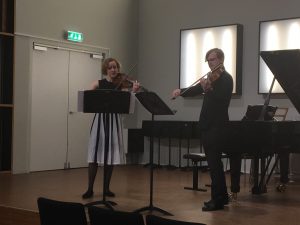
Joosep Ahun
Hierna komt Joosep Ahun, masterstudent uit Den Haag. Zijn Van Geel heeft een eenvoudige maar eigenzinnige improvisatie die een zware wissel trekt op zijn bas-stembanden. Mozart in G samen met Eva de Vries is netjes, maar een beetje kleurloos als je mag vergelijken met de beste uitvoeringen tot nu toe. Gerard Boeters begeleidt alweer voor de 4e keer vandaag in Enescu. Zeker niet slecht, maar hoe goed? Die vraag begint nu steeds heftiger op te spelen in de hoofden van menig kandidaat.
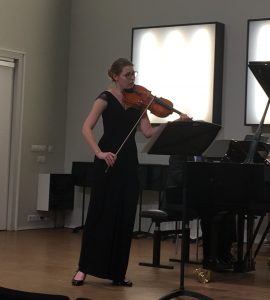
Olga Kowalczyk
De allerlaatste: Olga Kowalczyk opent met Mozart in G, zij wèl samen met haar zus, Maria. Nadeel voor haar is dat ik na een hele dag altvioolconcours niet meer weet of ik mijn oren goed kan vertrouwen. Maar volgens mij is er niet veel mis met deze Mozart. Na een “Skip Count” op volle toeren streelt de klankvorming in “Gesualdo” mijn vermoeide oren, en ook hier komt een zangstem in het spel. In het afsluitende Concertstuk melden mijn oren een paar ruwe plekken, maar zoals gezegd, die vertrouw ik nu al niet meer. Het is even doorbijten, maar ik geloof het maar al te graag als ik een prachtig opbouw naar het slotgedeelte hoor. Voilà! (of moet dat zijn: VIOLA!?): het is afgelopen.
Nu is de taak aan de jury. Er zijn in mijn boekje heel veel kanshebbers voor de 2e ronde. Ben benieuwd!
Drie kwartier later komt de uitslag – de volgende zijn door naar de 2e ronde: Evgeniya Peschanskaya, Hessel Moeselaar, Martin Moriarty, Lara Albesano, Lotus de Vries, William Murray, Take Konoye en Hannah Shaw.
Succes allemaal, morgen (vrijdag) vanaf 11.30u in de Haitinkzaal!
O ja, nog even de volgende extra juryprijzen:
Beste Mozart: William Murray
Beste Van Geel: Take Konoye (dat had m.i. wel Kellen McDaniel moeten zijn!)
~~~~~~~~~~~~~~~~~~~~~~~~~~~~~~~~~~~~~~~~~~~~
English Version:
We are up early today, in order not to miss a single note of the second day of this viola competition. The jury is clearly also eager to go.
Master student Lara Albesano kicks off the day with a very beautiful Mozart (in G major). The jazzy “Skip Count Sweet Miles” by Oene van Geel is technically very good, and performed with apparent ease! The Enescu was also very good, her playing is very mature. If I had to be very picky, a few times the sync with pianist Daniël Kramer is a tiny bit off. But she makes a clear statement here: There will be many competitors in the running for the 2nd round.
Kellen McDaniel hails from California, but currently studies with Zemtsov in The Hague. His opening statement is the Mozart duet in G, together with violinist Danielle Daoukayeva, with whom he has played for several years in the Babylon string quartet, and it shows. In spite of a few mistakes, it is a charming interpretation. The Enescu with Gerard Boeters is however played in ‘safe mode’. But then, preceded with a “one, two, one-two-three-four” – his “Skip Count” is easily the most catchy rendition so far, including a jumping bass player, alert timing and swinging energy. The bass player also assists with some deeper undertones in the “Gesualdo” improv, which Kellen makes good use of. Interesting turn!
The Turkish student Kardelen Buruk starts off with Enescu. A bit timid in the introduction, but gradually she reaches a good state of flow. Her Mozart is also good. In the “Skip Count” she loses track of the bassist for a while, but recovers nicely in time to finish the piece with bravoura. In the Gesualdo her improv includes a lot of flageolet notes, and a few juicy Bartok-pizzicato’s.
And then Lotus de Vries offers us a nice surprise: Finally someone who has chose the “other” Mozart duo in B flat (KV424). It is technically more demanding, especially for the violinist. But the key is very suitable for a sounding viola voice, and Lotus really succeeds in making that happen. In the improvisations of “Gesualdo” we hear first a folk song and in the next part something that makes me think of a motif from the Shostakovich 10th Symphony, but then much more intense. Finally, her Enescu was a bit ‘heavy’ at times, but she came out all right in the end.
Next up is Esther Fernandez Olalla, a student of Karin Dolman in Rotterdam. She is accompanied by Roderigo Robles de Medina in the Enescu concert piece, and that goes very well! She has booked a lot of progress since the masterclass with Richard Wolfe in January. “Skip Count” offers a dramatic plot twist – Esther is accompanied by her teacher, on the viola! Strictly speaking against the competition rules, but that makes it all the more fun. The relative lack of a steady base pulse is compensated in part by self-induced swing. Not bad! The Mozart offers a different “first”, that of a male violinist, a quite steady Manuel Muñoz. But I missed musical “suspense” in this piece.
Fourth-year student Sophie Vroegop enters the stage with Vera Werkman for the B flat Mozart duo. Some nices harmonies are made together, and in spite of some intonation issues, there is enough musicality. She then moves on to Enescu (with Gerard Boeters), succeeding in making good dynamic arcs. In the piece of Oene van Geel she appears with a live bass guitarist! That swings nicely. In “Gesualdo” another new invention is brought up: Improvisation in guitar style, with the viola tucked under the arm.
Up next: William Murray. Mozart in B flat with Cordelia Paw is a musical feast! In “Gesualdo” he starts singing out loud, and in combination with his viola it suddenly becomes a madrigal choir, fantastic! But his true prowess shows in Enescu, where he can fully exploit the power of his sonorous, deep Amati viola. He has a good stage presence, projecting confidence and pleasure in his work. I’m sure we will see him in the next round.
Takehiro (“Take”) Konoye is the youngest contestant of them all, but far from the least capable. He starts out with Oene van Geel, with a very good and virtuosic “Skip Count”. In “Gesualdo” he demonstrates that he also knows what to do with tone coloring and sound production. In the Mozart G-major duo he plays – to my surprise – with Shin Sihan, rather than his own twin sister Mayu, with whom he has already won several prizes as a duo. But mr. Sihan certainly knows his Mozart, so no problem. Take closes out with a very well-controlled Enescu.
Hannah Shaw participates in the category of “postgraduates”, and as such she can tap into a very grown-up network fo musical friends. Hence, in the Mozart duo (B flat), she appears with Ben Gilmore, the 2013 Oskar Back competition winner. She also manages well with the pieces by Oene van Geel, although the improvisations in “Gesualdo” are not the most original ones. She finishes with Enescu, accompanied by Daniël Kramer, a fine performance, albeit perhaps a bit on the “risk-averse” side, in light of her already significant professional experience.
We are nearing the end of the 1st round, only 3 candidates left. We have now heard the Enescu piece 15 times. Michiel Wittink brings us number 16, and quite meritably so. Some spots fall victim to stress-induced hastening, but he closes out with an elegant “Telemark landing” (to borrow some ski-jumping terminology), and receives deserved applause for this feat. The “Skip Count” piece is done very virtuosically, for a short while he is slightly behind the beat, but recovers. His the Gesualdo-improvs have a Yiddish flavour, in an Ernst-Bloch-like sense. His “home stretch” is a jubilant Mozart in G, together with Margot Kolodziej.
After this comes Joosep Ahun, Master student from The Hague. His “Gesualdo” has a simple but wayward improvisation which makes a big demand on his bass vocal chords. Mozart duo in G with Eva de Vries is totally OK but a bit bland when compared to the best renditions so far. Gerard Boeters then accompanies the Enescu for the 4th time today. Joosep’s version is certainly not bad, but how good is it? This question looms in many a candidate’s mind right now.
The last candidate, Olga Kowalczyk, starts with Mozart duo in G. Unlike Take, she does play with her sister, Maria. A disadvantage for her is that I’m starting to distrust my ears after a whole day’s worth of viola competition. But as far as I can tell, there’s not much wrong with her Mozart. After a “Skip Count” at full speed, her tranquil sounds in the “Gesualdo” is soothing to my weary ears. She throws in some vocal cords for good measure. In the final rendition of the Concert piece my ears signal a few rough spots, but like I said, they’re not to be trusted anymore. Hanging on with my last bits of auditive concentration, I am so willing to believe that I just experienced a magnificent build-up towards the finale of this piece. Voilà! (or should that be VIOLA!?). It is finished.
Now the rest is up to the jury. In my book there are many people in the running for the 2nd round. I’m curious!
Three quarters of an hour later we have the verdict of the jury – the following people go on to the 2nd round: Evgeniya Peschanskaya, Hessel Moeselaar, Martin Moriarty, Lara Albesano, Lotus de Vries, William Murray, Take Konoye and Hannah Shaw.
We wish you good luck tomorrow (Friday), starting at 11.30h in the Haitinkzaal!
Almost forgot, there were two extra jury prizes:
Best Mozart: William Murray
Best Van Geel: Take Konoye (that should have been Kellen McDaniel, IMHO!)


